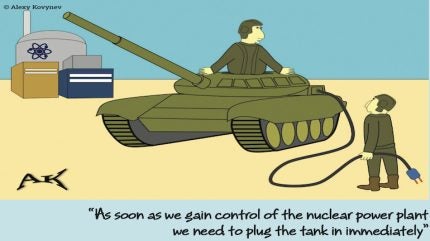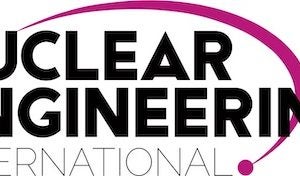
On 3 March 2022, Russian forces did the previously unthinkable and seized control of another country’s nuclear power plant. The world had never before witnessed such an act and it effectively shattered existing paradigms of nuclear energy security – eliminating some comforting narratives about the impregnability and sanctity of civil nuclear facilities. Despite this shocking development, what has emerged in its place is strangely reassuring.
For the vast bulk of the global nuclear industry, the moment when the flares fell over the besieged six-unit Zaporizhzhia nuclear power plant with gunfire taking place between armed forces is forever etched in the mind. It is right up there with the explosions at the Fukushima Daiichi plant as a moment that defines recent nuclear history. And yet unlike the Fukushima Daiichi accident, which had huge impacts on the fate of the industry and essentially ended the global nuclear renaissance of the time, the seizing of Zaporizhzhia and the earlier occupation of the Chornobyl nuclear site seems to have fallen from the collective consciousness. Why is this?
In the aftermath of Fukushima Daiichi accident there was a media panic and a public backlash, which sparked a global industry response to stress-test and improve safety at nuclear facilities worldwide. It was a truly impressive and arguably even excessive response to a previously unseen accident situation. it unquestionably led to a deeper and wider understanding of how to prevent and respond to future nuclear accidents.
In the immediate aftermath of the seizing of Zaporizhzhia there was a media panic… and then something of a collective shrug from the public and governments as the months ticked by and somehow the plant continued operating, stubbornly refusing to melt down. The IAEA got involved, placing inspectors on the site to make sure neither side engaged in nuclear sabotage, but even the constant reminders of the danger from the IAEA’s Secretary General Rafael Grossi seems to have done little to gain the attention of global leaders. Frankly, the longer the situation has dragged on, the greater the issue fatigue has become.
Indeed, perhaps counterintuitively, the Ukraine war may have done more to bolster nuclear energy prospects globally than dampen them as European governments especially scurried to cut back on their reliance on Russian gas supplies. This worsened a global energy shock that was already underway, with European countries guzzling up supplies from sources that had more typically served Asian markets.
This cost escalation, the apparently heightened threat of natural gas supply disruption, as well as the risk of a potential broadening of the war has reignited interest in nuclear energy as a sovereign and secure energy source. Even the Ukrainian government has not wasted any time in pressing ahead with new nuclear project development, already laying ceremonial concrete for as many as nine AP1000s.
Perhaps this is not surprising. Students of energy history will have seen the same in the graphs following earlier energy shocks and especially the oil crisis of the 1970s. This led to a wave of nuclear construction across Europe, perhaps best represented by the French programme. It is also no secret that there is a strong element of national pride associated with a country’s nuclear infrastructure and capabilities. As the spirit of nationalism grows, so too does support for nuclear technologies – energy or otherwise.
The plans for European newbuild are well and truly on the table. Even while some countries in the continent remain doggedly anti-nuclear – Germany for instance is completing its long in-process nuclear phase out – the conviction of this cause has nonetheless waned across the continent.
As for the nuclear supportive countries, how can they support nuclear energy facilities with the understanding that they might be targeted and captured if a foreign force invades? What lessons have been learned from the seizing of Zaporizhzhia?
At the political level the answer could well be nothing. Complacency is evident given there is a belief that such a situation will never take place on one’s own soil and trust that existing national defence arrangements and the protection of NATO make this a distinctly Ukrainian threat, and ultimately a Ukrainian problem to deal with. In truth, this would seem to apply not only to Zaporizhzhia but the entire war, where support for Ukraine has been limited and conditional.
At the industry level, if there is a global nuclear security response as a result of this act of occupation then it is hardly in evidence. It is, of course, entirely possible that something like this is underway, but is actually being kept secret. Where safety improvements are typically broadcast in order to improve public acceptance, security upgrades typically lose their efficacy once they are widely-known
What is evident is the following: No nuclear plant and its private security detail can be expected to stand up to invasion from a sizeable and well-armed military force. Therefore, the protection of the plant from such a threat must be a national responsibility. Bolstering private forces is at once unnecessary and may even increase risks if it potentially means more weapons and munitions are kept on site.
Nuclear power plants are robust and actually stand up fairly well to incidental damage caused by shelling and gunfire, at least when critical parts of the plants are not targeted. They are not, however, invulnerable. Nuclear plants are not fortresses, but they can in effect be coopted to act as such if armed forces are placed there. There is a natural reluctance by aggressors to target these facilities with heavy weapons because of the radiological hazard present. The use of nuclear plants for this purpose is to be condemned, but this does not stop it from being true.
Existing treaties, conventions and international governance arrangements around nuclear energy do appear to provide a protected status to nuclear plants. Countries, and especially those with their own nuclear sectors (and certainly export industries) are clearly reluctant to bring the disgrace that a widescale contamination event would inevitably entail. The same clearly does not apply to oil and gas infrastructure, as we saw with the destruction of Nord Stream 2.
Other infrastructure, and especially the grid itself is far more vulnerable during war. Indeed, the frequent episodes of loss of offsite power and risk of station blackout have been the among the most regular and serious ongoing threats to the Zaporizhzhia plant. The destruction of the Kakhovka dam demonstrates that energy and other infrastructure is much more likely to be targeted for destruction than nuclear facilities.
Nuclear power plants in fact become strategic assets during any conflict. Additionally so, as they can be expected to keep generating enormous amounts of power to a county/region even as fighting continues – potentially serving the electricity needs of both aggressors and defenders.
It might be argued that the above is specific to the Ukraine conflict and should not be generalised. However, a glance at other nuclear plants in conflict zones suggests it holds true.
Threats of missile attacks on Armenia’s Metsamor nuclear plant by Azerbaijani forces simply never materialised. The Barakah nuclear plant in Iran has not so far been targeted by Israeli retaliation. Put simply, it seems that no one wants to deal with the repercussions of a regional radiological contamination event. Especially if their troops/countries are in the region!
The same obviously does not apply equally to nuclear fuel cycle facilities. The targeting or Iranian enrichment facilities by the Stuxnet virus suggest that when the radiological threat is not there, countries are not afraid to attack. Therefore perhaps this is where industry efforts to improve security should focus.
For the reasons above it looks like we will see more nuclear plants built because of global security concerns, than not built because of them.






